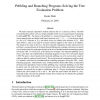Free Online Productivity Tools
i2Speak
i2Symbol
i2OCR
iTex2Img
iWeb2Print
iWeb2Shot
i2Type
iPdf2Split
iPdf2Merge
i2Bopomofo
i2Arabic
i2Style
i2Image
i2PDF
iLatex2Rtf
Sci2ools
118
Voted
CORR
2010
Springer
2010
Springer
Pebbling and Branching Programs Solving the Tree Evaluation Problem
We study restricted computation models related to the tree evaluation problem. The TEP was introduced in earlier work as a simple candidate for the (very) long term goal of separating L and LogDCFL. The input to the problem is a rooted, balanced binary tree of height h, whose internal nodes are labeled with binary functions on [k] = {1, . . . , k} (each given simply as a list of k2 elements of [k]), and whose leaves are labeled with elements of [k]. Each node obtains a value in [k] equal to its binary function applied to the values of its children. The output is the value of the root. The first restricted computation model, called fractional pebbling, is a generalization of the black/white pebbling game on graphs, and arises in a natural way from the search for good upper bounds on the size of nondeterministic branching programs solving the TEP - for any fixed h, if the binary tree of height h has fractional pebbling cost at most p, then there are nondeterministic branching programs o...
Branching Programs | Computation Model | CORR 2010 | Education | Nondeterministic Branching Programs |
Related Content
| Added | 09 Dec 2010 |
| Updated | 09 Dec 2010 |
| Type | Journal |
| Year | 2010 |
| Where | CORR |
| Authors | Dustin Wehr |
Comments (0)

